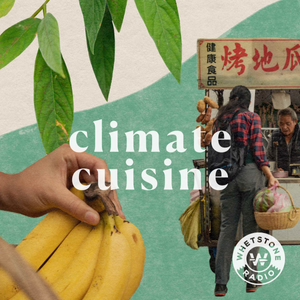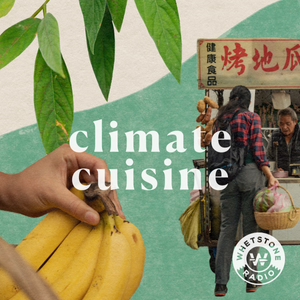
Climate Cuisine
Whetstone Radio Collective



5 Listeners
All episodes
Best episodes
Seasons
Top 10 Climate Cuisine Episodes
Goodpods has curated a list of the 10 best Climate Cuisine episodes, ranked by the number of listens and likes each episode have garnered from our listeners. If you are listening to Climate Cuisine for the first time, there's no better place to start than with one of these standout episodes. If you are a fan of the show, vote for your favorite Climate Cuisine episode by adding your comments to the episode page.

The Tropical Starch Behind Fufu and Boba
Climate Cuisine
12/08/21 • 29 min
Around the world, farmers are increasingly planting cassava rather than other crops to mitigate the effects of drought. Due to cassava’s drought-resistant qualities and ability to survive defoliation, it's an ideal crop for communities impacted by climate change and food insecurity.
In today’s episode of Climate Cuisine, we’re discussing how cassava has been feeding people throughout South America, Africa, and Asia. It is one of the most resilient starches out there and can be processed into bread, couscous, and even boba. We’re speaking with Pierre Thiam and Andrea Castillo to learn more about this incredible crop.
Climate Cuisine is part of Whetstone Radio Collective. Learn more about Climate Cuisine here.
Find show notes here.


3 Listeners
1 Comment
1

Why All the Bananas at the Grocery Store Taste the Same
Climate Cuisine
01/12/22 • 27 min
There are more than 1,000 different types of bananas in the world. So why do we only have one type of banana in the grocery store? This episode is an exploration into the rich diversity of bananas and plantains — and why North American grocery stores only sell one type. We talk with biologist Rob Dunn, who wrote a book about this topic, Von Diaz, an esteemed food writer and cookbook author, Meenakshi J., a freelance journalist who wrote an article about sacred bananas, Vidya Balachander, the South Asia editor at Whetstone, and Vanessa Mota, a food blogger behind My Dominican Kitchen, for more.
Climate Cuisine is part of Whetstone Radio Collective. Learn more about Climate Cuisine here.
Find show notes here.

2 Listeners

Meet Cilantro's Tropical Cousin: Culantro
Climate Cuisine
01/19/22 • 23 min
Meet culantro—cilantro’s tropical counterpart. It tastes like a more pungent cilantro, and in the right conditions, it grows all year round. This episode touches on how limited our repetoire of herbs are and the possiblities that come when we expand our selection beyond what's just avaliable at the grocery store. We’ll talk to food blogger Reina Gascon-Lopez on how culantro is used in Puerto Rican cuisine and award-winning cookbook author Andrea Nguyen on how she uses it in Vietnamese cooking.
Climate Cuisine is part of Whetstone Radio Collective. Learn more about Climate Cuisine here.
Find show notes here.

2 Listeners

The Heart-Shaped Tuber That Created Humankind
Climate Cuisine
12/15/21 • 25 min
Taro is the basis of many Polynesian creation stories and one of the world's oldest food crops. In fact, it is so important that the Polynesians carried it with them on their boats as they migrated across the Pacific Ocean. Every part of the tuber can be eaten, from the leaves to the tuber, and back in the day a healthy taro patch meant a clean and vibrant waterway. This episode dives into the reason taro is such a staple crop, a bit about all the varieties, and why you cannot eat it raw. We chat with Arthur Wierzchos, chef Lance Seeto, and Ryan Nebeker from FoodPrint for more.
Climate Cuisine is part of Whetstone Radio Collective. Learn more about Climate Cuisine here.
Find show notes here.

2 Listeners

This Fruit Can Feed a Whole Family
Climate Cuisine
01/26/22 • 26 min
The breadfruit tree can live up to 100 years and produce more than 2,000 pounds of fruit each season. It’s been a staple in the tropics for generations and can be made into chips, waffles, and porridge. This episode will dive into how it’s eaten in Puerto Rico and Hawai’i. Plus, a bit about its dark history in the slave trade. We’re talking about Mike McLaughlin from the Trees That Feed Foundation, Mike Opgenorth from the National Tropical Botanical Garden in Hawai’i, Juliane Braun, who wrote a paper about breadfruit’s role as an 18th-century superfood, and Von Diaz, a cookbook author and esteemed food writer.
Climate Cuisine is part of Whetstone Radio Collective. Learn more about Climate Cuisine here.
Find show notes here.
1 Listener

How Cactus is Used for Fashion, Fuel, and Food
Climate Cuisine
01/05/22 • 27 min
Cactus isn't just a pretty backdrop in Western movies. It can be used for food, fashion, and biofuel. In fact, some varieties of cacti use 80% less water than traditional crops. We talk with John Cushman, Adrián López Velarde, and Fadi Kattan and explore how it's a crop of the future, how it's been eaten for generations in Mexico, and how it's also a symbol of resistance in Palestine.
Climate Cuisine is part of Whetstone Radio Collective. Learn more about Climate Cuisine here.
Find show notes here.
1 Listener

This Legume Tree Naturally Fertilizes the Soil
Climate Cuisine
02/02/22 • 27 min
One of the staple pulses in Indian cuisine, the pigeon pea is much more than just a tasty ingredient in daal. It doubles as a natural fertilizer and can take nitrogen from the air and fix it into the soil. In this episode, we’ll talk with Aeles, an indigenous chef in Taiwan, about the ways her tribe cooks the pea; Vikram Doctor, a food journalist in India on how it’s used in Indian cuisine; and Koreen Brennan, a permaculture instructor based in Florida, on why it’s such a great plant to have in tropical gardens.
Climate Cuisine is part of Whetstone Radio Collective. Learn more about Climate Cuisine here.
Find show notes here.
1 Listener

Meet Bamboo: The Fastest Growing Plant in the World
Climate Cuisine
02/09/22 • 22 min
Bamboo is the fastest growing plant in the world; some varieties can grow up to three feet daily. Considered invasive in some parts of the United States, it is embraced in Latin America and Asia for its use in architecture, fashion and food. In this episode, we’ll chat with Hans Friederich, the former director of the International Bamboo and Rattan Organization; Momoko Nakamura, a food educator and storyteller in Japan; Kevindra Soemantri, a food journalist in Indonesia; and Hui Ting Tsai, a bamboo weaver in Taiwan.
Climate Cuisine is part of Whetstone Radio Collective. Learn more about Climate Cuisine here.
Find show notes here.
1 Listener

Why the Sweet Potato is Better than the Common Potato
Climate Cuisine
02/23/22 • 23 min
Sweet potato has a larger growing range than the common potato and can thrive from sea level up to nearly 9,800 feet. In the final episode of this season of Climate Cuisine, we’ll talk with a researcher at the International Potato Center in Peru about the incredible root, and a sustainability teacher in Costa Rica who has figured out how to grow everything she and her family consume.
Climate Cuisine is part of Whetstone Radio Collective. Learn more about Climate Cuisine here.
Find show notes here.

Food with Mark Bittman: The Glorious, Victorious Asma Khan
Climate Cuisine
06/28/22 • 39 min
Mark talks to the groundbreaking chef, Asma Khan, about the importance of the Anglo-Indian influence, how food and cooking are undervalued, and the beauty of interfamily lessons across generations.
Follow Mark on Twitter at @bittman, and on Facebook and Instagram at @markbittman. Subscribe to Mark's newsletter The Bittman Project at www.bittmanproject.com.
Show more best episodes

Show more best episodes
FAQ
How many episodes does Climate Cuisine have?
Climate Cuisine currently has 14 episodes available.
What topics does Climate Cuisine cover?
The podcast is about Society & Culture, Podcasts, Arts and Food.
What is the most popular episode on Climate Cuisine?
The episode title 'The Tropical Starch Behind Fufu and Boba' is the most popular.
What is the average episode length on Climate Cuisine?
The average episode length on Climate Cuisine is 26 minutes.
How often are episodes of Climate Cuisine released?
Episodes of Climate Cuisine are typically released every 7 days.
When was the first episode of Climate Cuisine?
The first episode of Climate Cuisine was released on Dec 8, 2021.
Show more FAQ

Show more FAQ